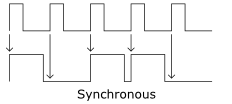These are all methods used to transfer streams of data. Waveform diagrams can be used to illustrate these different transmission modes. A waveform diagram shows how the signal might appear on an oscilloscope screen, which produces a diagram with voltage on the vertical axis and time on the horizontal axis.
Synchronous

Bits in a synchronous data stream must be transferred in sync with a clock signal. The control signals for the data are derived from a clock signal. Synchronous data transfer systems usually have an error detection mechanism. If an error is detected the data can be resent.
Asynchronous

Bits in an asynchronous data stream can be transferred at random intervals and the data rate of the stream is not required to be constant. Asynchronous systems use a start bit to signal the beginning of a data transmission. A stop bit is used to signal the end of a data transmission. Asynchronous data transfer systems usually have an error detection mechanism. If an error is detected the data can be resent.
Isochronous (pronounced "eye-sock-ron-us")

An isochronous data transfer system combines the features of an asynchronous and synchronous data transfer system. An isochronous data transfer system sends blocks of data asynchronously, in other words the data stream can be transferred at random intervals.
Each transmission begins with a start packet. Once the start packet is transmitted, the data must be delivered with a guaranteed bandwidth. Isochronous data transfer is commonly used for where data must be delivered within certain time constraints, like streaming video.
Isochronous systems do not have an error detection mechanism (acknowledgment of receipt of packet) because if an error were detected, time constraints would make it impossible to resend the data.
More Networking Basics:
• What is the Internet of Things?
• Synchronous, Asynchronous, Isochronous. What Does it Mean?
• Network Classifications: LAN, WAN, WLAN, SAN, MAN, and PAN
• Bluetooth Basics - Bluetooth Technology Tutorial
• What is an Ethernet Crossover Cable?
• Web Server
• Cellular WAN (Wide Area Network) or Mobile Broadband
• The Network Technician Career Field
• Workgroups and Domains
• Bluetooth in Brief

